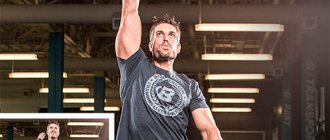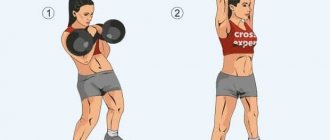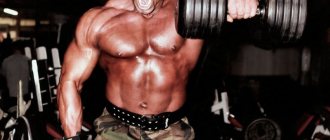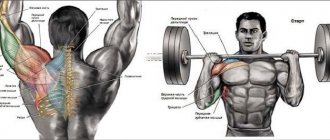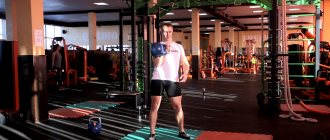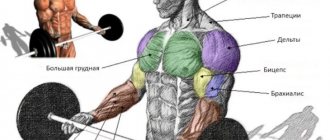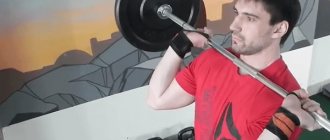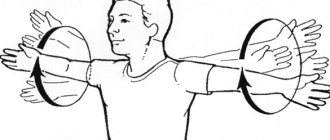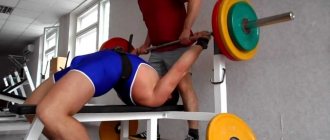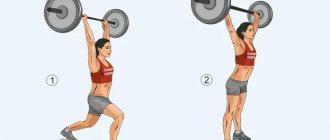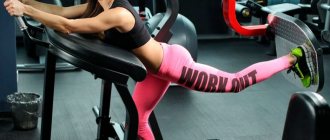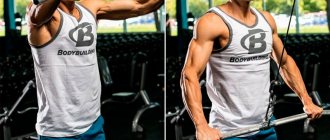| Emblem of the Kettlebell Lifting Federation |
| Weight-lifting |
|
| Theory |
|
| Inventory |
|
| Training |
|
| Competitive exercises |
|
| Preparatory exercises |
|
| Nutrition and recovery |
|
Kettlebell push with one hand: video
Eight
Want to pump up your core muscles? Then feel free to include the element in your program! In addition to the core muscles, the legs and arms work here. The essence of the element is to describe a figure eight around the legs with the projectile, for which you need:
- Place your feet slightly wider than your shoulders and take the weight in your right hand.
- Bend slightly forward with your knees bent and your back straight, bring the projectile between your legs a little further than your torso.
- Reach back with your other hand and take the weight from your right.
- Move the limb with the projectile forward and bring it back between your legs.
- With your right hand from behind, grab the kettlebell again.
The exercise perfectly develops coordination of movements, and it looks very impressive.
Rules for performing the exercise
Each exercise with weights is technically more difficult, so it is imperative to stretch your hands and shoulders well before starting the exercise so as not to injure your joints.
Starting position: Place the weight over your shoulder. The elbow is pressed to the body. The legs are straightened at the knee joints. Look forward (do not press, do not throw)
Phase 1: Next, perform a squat without changing the starting position. Perform a pushing movement by extending the legs at the knee joints, bending in the lumbar region. Lift off your heels to create momentum. The free hand does not touch other parts of the body and is in the down position.
Phase 2: Perform a squat, lower your heels to the floor. Perform extension in all joints. In the up position, the hand is strictly vertical.
Phase 3 (reset): Rise onto your toes and rotate your elbow forward. Drop the weight onto your shoulder. Press your elbow to your body. This is your starting position.
Repeat the exercise as many times as necessary. Variations of the military press with kettlebells can be the military press with a barbell or with kettlebells while standing and sitting. You can see the detailed technique for performing the exercise in the following video.
Learning to snatch a kettlebell - technique, breathing and other subtleties
The kettlebell snatch is a classic kettlebell exercise. It is performed in competitions along with the push of two weights. Shells of three different weights are used: 16, 24 and 32 kg. Traditionally, kettlebell exercises have been the preserve of weightlifting athletes. However, today kettlebell lifting has regained popularity and training using this equipment is carried out in a variety of disciplines, in particular in CrossFit. Many fitness clubs are equipped with kettlebells; not only men, but also girls show interest in such activities.
Why do the exercise?
The 16 kg kettlebell snatch (pudovki) is included in the list of tests for passing the GTO standards. The technique of performing the exercise in this case remains unchanged. The athlete continuously performs the exercise for 4 minutes, and the judges count the number of repetitions. In particular, to receive a gold GTO badge, a man under 40 years old must snatch a 16 kg projectile 40 times.
Kettlebell lifting began to appear in the 50s of the last century, and has now gained great popularity.
In order to cleanly perform a kettlebell snatch, an athlete must have physical strength, flexibility and the ability to accurately coordinate movements. What muscles work during a snatch? This exercise involves almost all muscle groups and requires enormous physical and energy output. Kettlebell lifting is a powerful tool for developing general physical fitness, strength and coordination.
Including the snatch exercise in your training program leads to the following positive effects:
- Development of strength and growth of the muscles of the back, legs and other muscle groups.
- Strengthen your hands and increase your grip strength.
- Increasing strength endurance and functional capabilities of the body, mastering breathing techniques.
- Training of motor coordination and the ability to tense and relax muscles under control.
- Development of speed indicators.
It is better to start mastering the kettlebell snatch by practicing its component movements. The technique is honed with a minimum weight of 16 kg, and then the weight of the projectile increases. For girls, even 16 kg may be too much weight, so it is worth saying that many fitness clubs have special equipment for women weighing less than 10 kg.
For girls, a 16 kg weight may be too heavy, so it is recommended to use lighter weights.
You can also use regular deadlifts and military presses as preparatory exercises.
Kettlebell lifting involves various variations of exercises. The competitive version of the snatch involves lifting a weight in a standing position with one hand, throwing the apparatus and performing the movement with the other hand without interruption. The same technique is used when passing the GTO standards.
16 kg weights are used when passing the GTO standards.
The starting position may vary: the weight can be placed in the middle in front of the athlete or behind one of the legs. You can also perform jerks while sitting in order to eliminate the work of the leg muscles for one reason or another. And finally, a snatch of two weights can be performed simultaneously or alternately.
Snatch technique
The kettlebell jerk is usually divided into several phases or stages, differing in the mechanics of movement.
Let's list them:
- Starting position. At this stage, the athlete must take the correct starting position, which will allow him to perform the snatch in the best possible way. The weight is placed at the distance of the foot from the legs exactly in the middle. The athlete places his feet shoulder-width apart, bends his legs, and straightens his back. A natural arch remains in the lower back. The projectile is grabbed with the palm from above, the second hand is straight to the side.
- Swing. Due to partial extension of the knees, the weight breaks away and, with a straight arm, like on a swing, is carried between the legs for a subsequent jerk forward.
- Detonation. From the swing, with a powerful short-term effort, the weight bursts forward. This is done at the moment when she has returned to the lowest point (on the line of the feet), due to the simultaneous extension of the legs, lifting on the toes, raising the shoulder and straightening the body. As it descends, the weight has already gained some inertia. After detonation, the projectile picks up speed and flies upward to a dead center. The hand holding the weight remains straight. The point of sticking to this rule is to maintain a rigid frame between the kettlebell, arm, body and legs. The second hand is still moved to the side.
- Podsed. At the moment when the accelerated projectile flies to the highest point and no force is applied to it, the athlete slightly bends his working arm at the elbow and quickly sits down under the weight. At this stage, the bend in the elbow and slightly bent knees are designed to soften the reception of the falling weight as much as possible. The hand turns outward, and the weight describes an arc around it and comes behind the forearm.
- Fixation. The athlete straightens his arm with the weight and straightens his legs. He remains in this position until the judge’s command that the exercise is valid (when passing the GTO test, this is from 0.5 seconds). When training on your own, you can linger at the top point for a second or more if you need to restore your breathing.
- Lowering. To perform subsequent repetitions, the apparatus is not placed on the floor; the movements are performed from a hanging position. The weight can be lowered to the lowest point in two ways - on a straight arm (pendulum) or by gradually bending the arm. The first method is good because it maintains the inertia of the projectile and does not reduce the speed of the exercise. Plus, in a straight position, the arm muscles can rest a little. The second method is designed to reduce the risk of hand injury, however, the muscles are under load all the time.
- Swing to intercept and intercept. In order to change the working hand, the athlete, after the next swing, lifts the weight to a dead point and intercepts the bow. The weight is lowered into the swing again, and jerks begin with the other hand. The technique of movements is completely similar to that described above.
Phases of the jerk: 1 - start, 2 - swing, 3 - undermining, 4 - sitting down, 5 - fixing, 6 - lowering, 7-9 - swing to change hands, 10-13 - performing a jerk with the second hand.
During the snatch, the athlete can be in a low or high stance. In the first case, there is a significant angle in the hip joints, and the weight sweeps just above the floor.
With a high stance, the posture is straighter, the angles at the knees and hips are much smaller, and the projectile is carried at the level of the knees. It is more beneficial from the point of view of saving muscle energy, however, it injures the hands more.
Breath
Among other things, kettlebell lifting involves precise training of breathing techniques. If you do not pay attention to this, the body will not receive enough oxygen for intensive work, which will certainly affect the results. The muscles will quickly tire, and the desired benefits of training will turn out to be harmful.
If you breathe incorrectly, your muscles quickly tire. Strength sports involve exhaling when performing an effort and inhaling during the muscle relaxation phase.
During a jerk, breathing can be done in 2, 3 cycles or more. The best option is 3 cyclic breathing:
- Inhale – lift the weight from the floor.
- Exhalation is the end of the explosion.
- Inhale - squat.
- Exhale – straighten the body and arms.
- Inhale – lower the weight from the top point to chest level.
- Exhale – lowering the projectile until it goes into the backswing.
In the event that there is still not enough oxygen, the athlete can do several breathing cycles at the moment of fixation. This will slow down the speed of the exercise, but will provide an opportunity to restore oxygen reserves. If high-speed and short-term work is necessary, the number of cycles per lift can be reduced.
Having mastered the kettlebell snatch, you can move on to practicing a more complex element - the push. You should also start with 16 kg. Or, if you just love kettlebell lifting, and participating in competitions or receiving a GTO badge is not part of your plans, you can limit yourself to simpler exercises.
Muscles involved in the exercise
Let's look at what muscles work when performing a kettlebell push with one hand. During the kettlebell push, a large number of different muscle groups work, the main load falls on the deltoid and trapezius muscles. The triceps, biceps, forearm, quadriceps, gluteal muscles, upper back, and core muscles (lumbar muscles and abs) play a supporting role.
Some muscles work more, some less, which, in particular, depends on the technique of performing the push, but, nevertheless, the push allows you to work almost the entire body. It is especially important to practice coordination of movements, their synchronization and sequence, so as not to get confused and not cause injury to yourself.
Important! When performing the exercise, the hand must be strictly fixed to avoid injury.
Exercise 12. Push of two weights
Execution technique.
The push of two weights is performed with weights weighing 24 kg.
There are two weight scales up to 70 kg and 70 kg and above.
Weights with handles placed crosswise in front of the legs at a distance of 20-30 cm.
The exercise is performed from the starting position: legs apart, shoulder-width apart, grip on top of the arms of the weights.
From this position, it is necessary to lift the weights off the floor, lift them to the chest, with straightened legs shoulder-width apart, the back straight, elbows lowered and pressed to the body, weights lying on the forearms and shoulders, the arms of the weights on the chest.
After a slight squat, push the weights up by sharply straightening your legs.
After doing a squat and “picking up” the weights with your straight arms, straighten your legs and fix the weights at the top on your straight arms.
To repeat the cycle, lower the weights to your chest and repeat the exercise.
At the end of pushing out - a short breath, in the fixation position - exhale-inhale, while lowering - exhale, in the starting position - inhale-exhale.
The position of the weights at the top is fixed with straight arms until the command of the manager (counter) “Yes!” or not!". The manager (counter) must immediately give the command “Yes!” if the exercise is performed correctly after fixing the weights for at least 0.5 seconds.
The student has the right:
— use magnesium to prepare the palms and handles of weights.
The student is prohibited from:
- use any devices that make it easier to lift weights, including gymnastic pads;
- use rosin to prepare your palms.
Errors when performing u-FP-12 (push of two weights)
| Minor (but the push is protected) | Significant (the push is not defended or the exercise is stopped) |
| There was a minor violation of the rules for fixing the weights, which the student corrected after a warning. | Errors punishable by the “No!” command: It is allowed to push the weights with a break in the movement, i.e. pushing, pressing. The weights were lowered before the command “Yes!” was pronounced. There is no fixation in the starting position and at the top. Errors punishable by the “Stop!” command: Alternating pushes of weights from the chest were performed. The weights are lowered from the chest to a hanging position. An error has been made that could result in injury. The trainee placed one or both weights on his head, shoulder, leg or platform. The exit from the platform has been completed. A three-time violation was committed, marked by the commands “no!” and/or the student was warned three times. |
Table of points for performing U-FP-12 (push two weights)
| Ball. | Col. once | Ball. | Col. once | ||
| up to 70 kg | over 70 kg | up to 70 kg | over 70 kg | ||
| 100 | |||||
Note: The standards presented in the table correspond to sportswear: 1C (swimming trunks, shorts, T-shirt, sports shoes). In this form, by decision of the commander (chief) of a military unit (military educational institution), under appropriate conditions, it is allowed to practice without a T-shirt and shoes; 2C (in shorts, T-shirt, sports shoes); 3C (in a sports (training) suit, sports shoes); 4C (in an insulated sports (training) suit, insulated sports shoes, a sports hat).
Table for assessing the physical fitness of military personnel
Source: voen-pravo.ru
This is interesting: Swing with a kettlebell: technique of performing the exercise, how to learn how to swing with a kettlebell correctly
Benefits of Kettlebell Push
- Strengthens the ligamentous apparatus. This occurs due to the shifted center of gravity of the projectile.
- Affects the synthesis of testosterone in the body. Due to the fact that the load is divided not only into small muscle groups (triceps + deltoids), but also the muscles of the legs and back are used - the largest muscle groups in the body.
- Requires pre-warming up. Like any basic exercise, it requires careful preparation, because, despite its apparent ease, lack of warm-up will most likely lead to injury.
- Helps develop explosive strength. Due to the impulsive nature of proper technique, it affects the strength of the legs and lateral triceps much more than the deltoids.
- Develops strength endurance. Due to the constant static load on the shoulder muscles and the multi-repetition style of pushing.
- Helps strengthen coordination endurance. Correct technique makes lifting easier by about 30-40%, so maintaining it is necessary to achieve high results, therefore, with constant training, the body begins to get used to the trajectory of the projectile.
TOP 5 mistakes in kettlebell pushing technique and ways to eliminate them
Vitaly Pavlenko
Good day, friends. I want to review the 5 most common mistakes in the kettlebell pushing technique and tell you the reasons for their occurrence and how to eliminate them. Errors occur not only among beginners, but even among masters of sports there is at least one mistake that haunts them. Therefore, to avoid such problems in the future, correct your mistakes as early as possible. Then it may already be too late, and it’s not really necessary, since with one mistake the result can be quite good (but without it it would be better).
The most common mistakes in the pushing technique will come first.
Mistake #1. The elbows are not inserted into the ilia in the starting position before pushing out
This error significantly reduces the efficiency of the push and slows down the acceleration of the weights. The energy accumulated during powerful pushing is dissipated. The elbows should be pressed tightly against the body to transmit momentum.
This is probably the most tricky problem for beginner weight lifters. Some people simply physically cannot insert their elbows into the ilia. If you are one of these people, then use a belt and insert your elbows into it (but often everything is not as hopeless as it seems, and there are ways to fix this problem).
This often happens due to overly pumped breasts, or just normal athletic breasts. You always have to sacrifice something for the sake of the result, and for weightlifters this is that same sacrifice. In principle, we don’t really need the chest to work with weights, so it’s better not to pump it.
Try to find your comfortable position, just stand in a rack with working weights (or heavier ones) for several minutes, get used to it and look for your comfortable position. While standing, try to relax your arms and shoulder girdle as much as possible.
Mistake #2. Incomplete straightening of the arms while fixing the weights at the top
A very common problem that sometimes even occurs among sports masters.
The reason for this is usually insufficient flexibility in the elbow joints or incorrect position of the weights.
Try pushing out light weights and standing with them for 30-60 seconds. This way you will quickly find your comfortable position. Try turning the weights slightly to the sides (with their bottoms to the sides, and your palms, on the contrary, so that they look more at each other), you will immediately notice that it is much easier to fix the weights this way.
After each workout, do stretching exercises in your elbow joints. Hold light weights at the top and try to force your elbows outward. And even during the main workout, try to turn your elbows outward (even if it hurts), but it will be worth it in the future.
Mistake #3. Tense legs while fixing weights at the top
This error is completely unacceptable. Although it does happen often. By not relaxing your legs in the upper position, you are depriving them of their only opportunity to rest, keeping them tense throughout the entire time.
If you make this mistake, the exercise will end precisely because your legs will get clogged, and very quickly.
The push of the weights is accompanied by shaking of the thigh muscles after straightening the legs at the knees; it is at this moment that the legs turn off and rest, and the entire load goes to the back and shoulders.
After your push workout, grab some light weights and push. Hold the weights up until your leg muscles are completely relaxed, then lower them. Each time try to relax faster and faster. Until there is no visible shaking at the moment of straightening.
Mistake #4. Too much shock absorption when lowering the weights to the chest
By making this mistake, you are doing a lot of unnecessary work with your legs, which will tire them out very quickly. For beginners, this is still acceptable, but then you need to get rid of this habit and try to lift weights with almost straight legs. There is, of course, a psychological barrier involved here, because from the outside this dropping of weights onto the chest seems quite tough.
In order to correct this error you need to slightly adjust your technique. When the weights are lowered onto your chest, you need to raise your shoulders a little and, as it were, stretch towards the serving weights (you can stand on your toes a little). As soon as the weights touch your shoulders, you need to lower your shoulders along with them, insert your elbows and stand on your full feet. Do not bend your knees (you can bend them quite a bit if the weights are still very heavy for you). There is a whole article about this on the website, which is called “Dropping weights on the chest.” Technique and movement progression.
Mistake #5. Incomplete straightening of the legs at the moment of pushing out. Weak push from the chest
More common in athletes with weak legs. Legs are everything to us, they must be strong, this will solve many problems.
As a result of this error, the weightlifter gives weak acceleration to the weights upward, which is why you have to go deeper under the weights at the moment of fixation, and this loads the legs even more.
To correct this mistake, it is recommended to develop explosive leg strength. It is best to do the following exercises:
- partial squats with a barbell to develop strength;
- jumping with a barbell with an incomplete squat, to develop speed and strength qualities;
- half-push of heavy weights to a level just above the head (without fixation) with an exit on the toes (this is more of a leading exercise for complete beginners).
You can watch a good technique where all 5 points are taken into account in the video
Conclusion
Of course, there are still a lot of different errors. I named only 5. The main mistakes also include:
- At the moment of fixation, the weights are pulled forward or diverged to the sides;
- The squat is too low for acceleration before ejection;
- Weak drop after pushing out, etc.
But these are no longer such common mistakes, and they are more common only in the first stages of learning and are quite easily corrected almost on an intuitive level.
Thank you for your attention!
Complex training
The exercise can be used both in training the arms and shoulders, and in training the back or in “fulbadi” (full body training). In this paragraph we will give an example of a workout that involves pushing a kettlebell with one hand.
300 Spartans
Task: complete the following exercises as quickly as possible without stopping. 25 pull-ups; 50 deadlifts 60kg; 50 push-ups; 50 jumps on a pedestal 60-75cm; 50 polishers (touch both sides = 1 time); Take 50 pushes of a weight (dumbbell) from the floor. 24/16 kg (25+25); 25 pull-ups.
Application in sports disciplines
The small size of the kettlebell and its unique properties are used in the training of athletes in many sports.
In first place, of course, is kettlebell lifting. The one-arm snatch and the push of two kettlebells at the same time are competitive exercises.
All the positive properties of this equipment were also appreciated in CrossFit . Exercises with it, including the clean and jerk, form a significant part of the training process in this sport.
To a lesser extent, but still during certain periods of preparation, the exercise is used in weightlifting, powerlifting and strongman.
When it comes to bodybuilding, the kettlebell jerk is rarely used.
It can be used during strength training periods to provide variety in strength development.
Or during periods of working on relief (with minimal weight of the projectile), as a fairly energy-intensive exercise that stimulates increased calorie burning.
In other sports, for example, in athletics, the clean and jerk is used during periods of general physical training, or as an auxiliary exercise for the development of speed and strength qualities.
Alternative Exercises
The one-handed kettlebell push is aimed at developing the muscles of the shoulder body, as well as the trapezius muscles. In this section, we will look at exercises that can be used as a replacement or as an addition to the one-arm kettlebell push.
One such exercise would be the two-handed kettlebell push. The exercise is identical to the kettlebell snatch with one hand, the difference is the participation of two hands and two kettlebells, respectively. It is more difficult than the one-handed kettlebell push. First you need to master this exercise, then move on to pushing two weights.
Two-handed kettlebell push
Military one-arm kettlebell press. The exercise uses the same muscles as the jerk. The difference between pushing a kettlebell with one hand is the inclusion of the leg muscles in the work. When performing a military press, the entire load is performed by the shoulders and arm muscles.
One-arm kettlebell military press
An alternative to the kettlebell push can also be push presses. Here the main load goes on the deltoid muscles and back muscles. The supporting muscles will be the quadriceps and gluteal muscles. The exercise is simple, aimed at developing strength endurance.
Press press
Common Mistakes
The correct push of a kettlebell is a rather technically complex exercise. Most amateurs prefer to do bench presses instead. This is when lifting the weight up is carried out only with the hand, without the help of the legs.
By the way, at kettlebell lifting competitions, lifting the apparatus without using the legs is considered a gross technical error, which is not counted.
The main rule of pushing is to start the movement from the feet.
A powerful straightening of the hips sets the impulse to move the weight upward. And only when the projectile is in the flight phase, a hand is activated to help press it.
Another common mistake is a strong deviation of the body to the side in the upper phase.
In this case, a fairly large load is placed on the spine, which can adversely affect the health of the back.
To avoid this mistake, pay close attention to the movement of your legs. If their impulse is strong enough, then you simply place your hand under the weight flying upward. And at the same time with this movement, you seem to sit down under the weight.
If the speed of the projectile is not sufficient, then in the upper phase it is pressed with hand force. As a result, the body tries to “help” and tilts the body in order to additionally involve other muscles in the work.
Standards for the kettlebell push
The kettlebell push is a competitive exercise in kettlebell lifting. The following are tables of grade standards for men and women for 2018-2021.
TABLE OF DISCHARGE STANDARDS FOR MEN: DC push (number of weight lifts in 10 minutes)
| Weight category (kilogram) | MSMK kettlebell 32kg | MS kettlebell 32kg | KMS kettlebell 32kg | I weight 24kg | II kettlebell 24kg | III kettlebell 24kg | I(u) kettlebell 16kg | II(u) kettlebell 16kg | III(u) kettlebell 16kg |
| 48 | — | — | — | — | — | — | 40 | 35 | 30 |
| 53 | — | — | — | — | — | — | 48 | 42 | 36 |
| 58 | — | — | — | 55 | 45 | 35 | 55 | 48 | 40 |
| 63 | 59 | 44 | 35 | 60 | 49 | 39 | 61 | 51 | 42 |
| 68 | 72 | 56 | 45 | 65 | 54 | 43 | 66 | 56 | 46 |
| 73 | 76 | 62 | 48 | 70 | 58 | 46 | 71 | 61 | 51 |
| 73+ | — | — | — | — | — | — | 74 | 64 | 54 |
| 78 | — | — | — | 74 | 62 | 50 | — | — | — |
| 85 | 82 | 69 | 55 | 79 | 66 | 54 | — | — | — |
| 85+ | 88 | 75 | 58 | 90 | 75 | 60 | — | — | — |
TABLE OF DISCHARGE STANDARDS FOR WOMEN: DC push (number of weight lifts in 10 minutes)
| Weight category (kilogram) | MSMK kettlebell 24kg | MS kettlebell 24kg | KMS kettlebell 24kg | I weight 16kg | II kettlebell 16kg | III kettlebell 16kg |
| 63 | 59 | 44 | 35 | 60 | 49 | 39 |
| 63+ | 72 | 56 | 45 | 65 | 54 | 43 |
CONVENTIONAL ABBREVIATIONS: MSMK - master of sports of international class MS - master of sports KMS - candidate master of sports I - first category II - second category III - third category I (u) - first youth category II (u) - second youth category III (u ) - third youth category
Conclusion
Training with kettlebells will harmoniously develop all the muscles of the body, improve coordination, and make you strong and resilient. Such exercises are very energy-intensive, and by doing them every day, you will lose excess weight and become slimmer and more graceful. But before you rush into battle, carefully study the correct technique and do not make gross mistakes.
If you liked the article, share it on social networks and subscribe to our VKontakte and Telegram groups. There you will learn how to quickly get your body in shape and lose weight.
Contraindications
- Not recommended for significant scoliosis, above grade 2. However, some athletes perform the exercise with lighter weights. This applies mainly to professional sports;
- Injuries to the hand, fingers, shoulder joint and arm should also be considered a contraindication;
- Strictly not recommended for lumbar hernias and hernias and protrusions in the thoracic region;
- It is better to replace it with standing forearm abductions during rehabilitation after rotator cuff injuries;
- It is not recommended for those who suffer from intercostal neuralgia or whose trapezius muscles are overloaded due to the presence of heavy pulls or shrugs.
Inclusion in the program
- This is a strength exercise. It is performed for 5-8 repetitions in 3-4 approaches. It is usually included in the program as the main exercise for the shoulders, if we are talking about bodybuilding, or as a second or third exercise, if it is used to practice the pushing technique.
- Working in failure is not recommended. Most non-professional athletes will use their legs in this exercise if given such a task.
- The load should increase smoothly. If it is not possible to use a wider range of weights, you can use rubber. It will increase the resistance in the upper third of the exercise;
- Tires are selected individually. Girls start with elastic bands with a resistance of 10 kg, guys - 15 kg. You can also use smaller rubber bands, but it is advisable to use tourniquets rather than thick, wide elastic bands from fitness kits;
- Vertical presses with kettlebells can also be planned in such a way that most of the load is performed with a medium weight and a number of repetitions closer to 5-8, rather than in a low-rep mode. Some athletes perform the main volume with one arm, and then “finish off” with bench presses alternately;
- If the plan includes a standing barbell press, then perform it first, and then do weight presses in a reduced volume. If the athlete performs both presses, the anterior deltoid may not be performed in isolation; in general, it is recommended to compensate for the entire volume of the load with exercises on the posterior deltoid muscle.
Data
- An impressive result in the standing press belongs to the Russian athlete Peter Krylov. He pressed a 32kg kettlebell a whopping 86 times. It is believed that competitive athletes should train with this type of kettlebell;
- The kettlebell press was one of the exercises of competitive kettlebell lifting, but then it was excluded from the program due to lack of entertainment and too complex criteria for evaluating the technique;
- Kettlebell lifting guru in the West, Pavel Tsatsouline, believes that the standing kettlebell press is much more useful than the bench press of barbells and dumbbells. It engages both the upper chest and triceps, as well as the deltoids and promotes harmonious muscle development. In addition, the situation when you need to pick up something and put it on a shelf occurs much more often than when you need to do push-ups from the floor, for example, so standing kettlebell press helps prevent household injuries. This is especially useful due to the fact that we press while standing first with one hand, then with the other, and we also lift things most often with one hand;
- Adequate weights are selected depending on strength and body weight. Most people should start not with a third of their body weight, as sources recommend, but with a quarter or one-eighth. Fitness sources recommend that girls start training with a 4kg kettlebell and guys start with an 8kg kettlebell. Then progress accordingly to 8 and 16 and further, as the sports result increases.
How to choose kettlebells
Whereas previously kettlebells were sold in weights of 4 kg, 16 kg, 24 kg and 32 kg, now you can find almost any kettlebell weight you want. The greater the weight of the weight, the higher its cost. Depending on the material used, weights are divided into plastic, neoprene, cast iron and steel.
Plastic weights
Ideal for training at home, they do not create much noise when colliding with a surface, and the furniture and floor will remain safe and sound. The downside of plastic weights is that their service life is shorter compared to, for example, cast iron or steel. Although if you buy plastic weights from trusted brands, they will last you a long time.
Cast iron weights
These weights are worth choosing for those who value reliable quality. Cast iron weights have high anti-corrosion properties, they are time-tested and will serve you for a long time. But if used carelessly, cast iron weights can scratch the floor or even cause injury to the user.
Steel weights
Weights made of chrome steel have a pleasant appearance and reliable construction. In addition, such weights are also available with a collapsible design, which is very convenient from the point of view of weight regulation. The price of steel weights is slightly higher.
Neoprene weights
The special feature of this type of weights is the soft neoprene coating. Such weights are not so often found on the market, but they are quite practical and safe. Especially suitable for beginners.
Plastic and neoprene weights are safer to use, they are better suited for home use and are cheaper. Cast iron and steel weights generally last longer and are more reliable over long periods of use.
If you are planning to purchase all-metal weights, it is better to get one that is covered with a rubber or vinyl coating to avoid scratching the floor and not creating too much noise. Weights are filled mainly with sand, cement and metal shavings.
To summarize
The kettlebell jerk is a unique exercise that develops the entire body. It is interesting not only because it is suitable for both men and women, but also because variations in execution will not allow you to get bored from routine execution. In addition, the cost of Soviet weights on the second-hand market makes this projectile accessible to everyone. After all, on average, a pair of old cast iron weights costs several times less than a set of dumbbells of the same weight. Using kettlebells allows you to do without the gym for a long time, developing all muscle groups with one movement or another.
Who is suitable for kettlebell training?
First, we need to separate kettlebell lifting and fitness. The first is an endurance competition in the kettlebell snatch and kettlebell clean and does not involve the athlete performing any other movements with the kettlebell. Typically, professional weightlifters do general physical training in the gym with a barbell, dumbbells, and in simulators. To improve the overall endurance of the body, they run cross-country or swim in the off-season. Kettlebell lifting makes a person resilient and “dry,” but training requires a lot of time and a competent approach. The year is divided into a season and an off-season; during the season, most of the training takes place in kettlebell exercises; during the off-season, more attention can be paid to pumping up and endurance training. Girls are attracted to kettlebell lifting because it does not contribute to the building of large muscles, and it allows you to increase calorie consumption so much that nutrition in everyday life does not need to be particularly limited.
Kettlebell fitness attracts people with completely different parameters. Kettlebells help increase endurance, improve your figure, burn excess fat, and at the same time they are inexpensive and do not take up much space in the apartment. A pair of weights and a rubber expander will fit into any interior. Whereas only fans will have barbells, dumbbells, and benches. Kettlebell fitness helps you organize short, intense workouts, saves time and allows you to save energy for other things. It is enough to learn how to handle weights once, and you will not need to choose gyms, travel around the city, and also waste time on the road to the fitness center.
Of course, kettlebells cannot be a universal tool for all purposes. They are not suitable for those who want to build significant muscle mass and are looking to increase muscle size enough to compete on the bodybuilding stage. Kettlebells will not help you shape your figure if the goal is to gain a few kilograms of muscle; they will only strengthen what you already have and lead to slight hypertrophy.
There are opposing points of view regarding weights and older clients. Domestic specialists with medical education usually advise going swimming or Pilates to protect your joints and spine. But kettlebells are still more suitable for older clients of sports clubs because they do not create a torsion load on the back, unlike swimming, and do not contribute to overload of the ligaments, unlike Pilates in a simulator. In the great task of mastering weights, a competent instructor is important.
Children and women can also engage in both kettlebell fitness and sports. Training does not put stress on the spine and does not interfere with children's growth. And for safe mastery of the technique, there are padded or rubber weights so that children do not injure their forearms while they learn to lift them.
